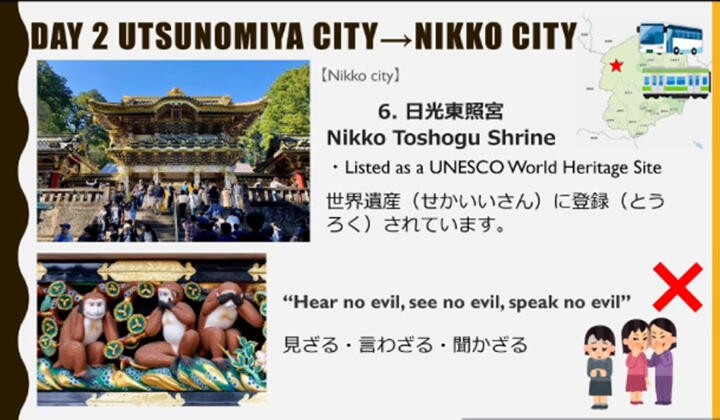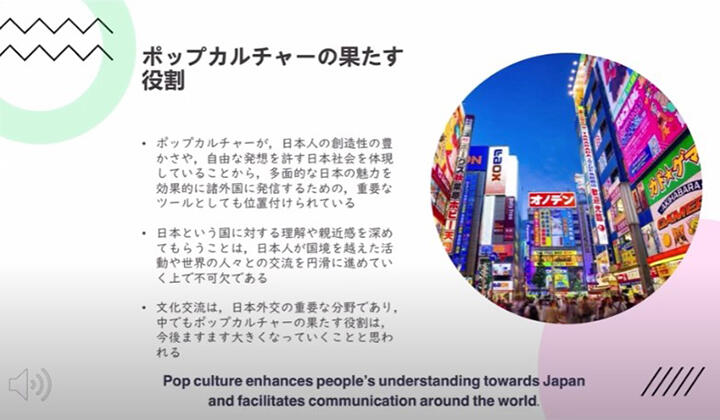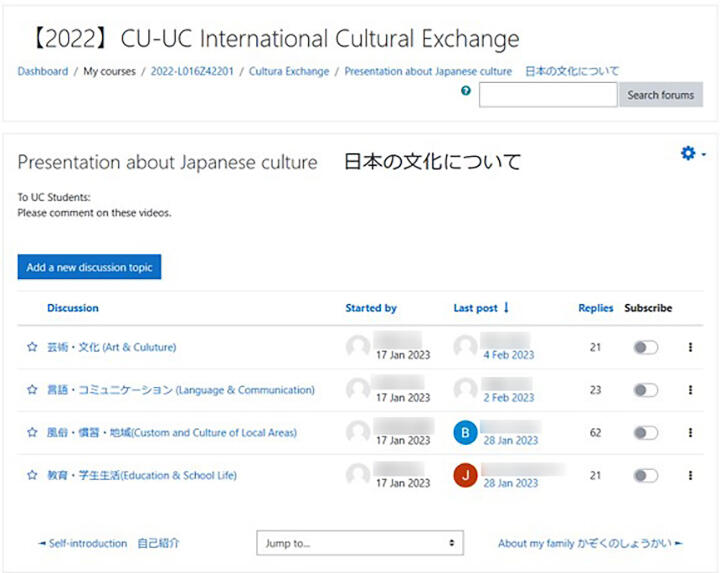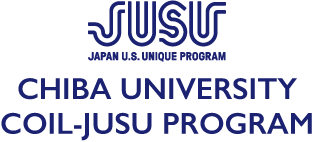International Cultural Exchange



Partner university (faculty)
Faculty of Letters, Chiba University University of Cincinnati
Class schedule
October2022 ~ November2022, January2023
Time difference
13 hours
Class objectives
This program aims to contribute to the Japanese language and culture education of Cincinnati students and to promote exchange among students and the internationalization of Chiba University, by having students from Chiba University and the University of Cincinnati study together online. Through active learning, by creating video content to be presented to students from the other country and exchanging opinions through comments, students learn about each other's culture, language, and society, and understand the current situation and issues of globalized society, as well as the meaning and significance of Japanese studies from a global perspective.
Class content
Participants in the program include students enrolled in "International Exchange Theory b" and several faculty members from Chiba University, University of Cincinnati faculty member Junko Markovic, and students studying Japanese at the University of Cincinnati.
The program was implemented using the Japanese and English versions of Moodle, and Google Chat. All students from Chiba University made individual self-introduction videos, students at the University of Cincinnati uploaded their self-introduction videos to the English version of Moodle as well, and the two groups exchanged comments.
In the second phase of the exchange, Chiba University students were divided into thematic groups to jointly produce video content in English and Japanese. At that time, each group used a Google Chat space to consult and create content.
After uploading the content, participants conducted online discussions and other communication in English and Japanese. (e.g., an online discussion among students through paragraph-length texts in response to a question from a Cincinnati student.) However, due to the time difference and other factors, synchronous interactive discussions were not held.
In addition, Chiba University students commented in Japanese and English on "family introductions" prepared in Japanese by students from the University of Cincinnati.
The exchange periods were two weeks each, from late October to mid-November, and from mid- to late January of the following year.
Class format
asynchronous
Tools used
Moodle, COIL-Moodle, Google chat
This academic year, Chiba University students were divided into four groups to create thematic video content. The themes were:
- Education and Student Life Group
- Language and Communication Group
- Customs, Practices, and Regions Group
- Arts and Culture Group
For example, because members of the "Customs, Practices, and Regions" group were from different backgrounds, they created a video that simulated a journey: "We decided to have each member develop a sightseeing plan about one prefecture and connect them together to create an imaginary travel experience. The season is November, the tourists are Americans, and after landing in Tokyo, they enjoy a trip on this itinerary: Tochigi, Miyagi, Toyama, Kyoto, and Aichi." (from a student report)
実施大学(学部)
千葉大学文学部 シンシナティ大学
授業日程
2022年10月~11月、2023年1月
時差
13時間
授業目的
千葉大学とシンシナティ大学の学生がWeb上で共に学ぶことにより、シンシナティ学生の日本語・日本文化学習に寄与するとともに、学生同士の交流と千葉大学の国際化を促進することを目的とする。相手国の学生に提示する映像コンテンツを作成し、コメントで意見を交わし合うというアクティブ・ラーニングによって、双方の文化・言語・社会を学び合い、グローバル化社会の現状と課題、世界から見た日本研究の意味・意義を把握する。
授業内容
本プログラムの参加者は、千葉大学の「国際交流論b」の履修者および複数の教員、シンシナティ大学教員の順子マルコビッチ氏、およびシンシナティ大学で日本語を学習している学生である。
プログラムはMoodleおよび英語版Moodle、google chatを利用して実施した。千葉大学の履修学生は、全員が個人での自己紹介動画を作成、シンシナティ学生も同様に自己紹介動画を英語版Moodleにupし、コメントでの交流が行われた。
第二期の交流では、千葉大学学生がテーマ別のグループに分かれ、英語+日本語による映像コンテンツを共同制作した。その際、google chatのスペースを利用して、グループごとにコンテンツ内容の相談と作成を行った。
コンテンツの提供後は、Web上での英語+日本語によるディスカッション等の交流を実施した。(例:シンシナティ学生の質問に対し、1パラグラフ程度のテキストによる学生同士のオンランインディスカッション。)ただし、時差等の関係で、同時刻の双方向型ディスカッションは行わなかった。
また、シンシナティ大学の学生が日本語で作成した「家族の紹介」に、千葉大学学生が日本語および英語でコメントした。
交流時期は、10月下旬から11月中旬と、年明けの1月中旬から下旬の、それぞれ2週間であった。
授業実施形態
非同期型
使用ツール
Moodle, COIL-Moodle, Google chat
今年度、千葉大学の学生は4グループに分かれてテーマ別の映像コンテンツを作成した。内容は以下の通り。
- 教育・学生生活グループ
- 言語・コミュニケーショングループ
- 風俗・慣習・地域グループ
- 芸術文化グループ
例えば「風俗・慣習・地域」のグループでは、それぞれの出身地が異なることから、「メンバーそれぞれが1つの県についての観光プランを練り、それを繋げて架空の旅行体験をしてもらおうということになった。季節は11月、観光客はアメリカ人の設定で、飛行機で東京に降り立った後、栃木→宮城→富山→京都→愛知という経路で旅行を楽しんでもらう」(学生レポートより)という模擬旅行風の映像が作成された。

